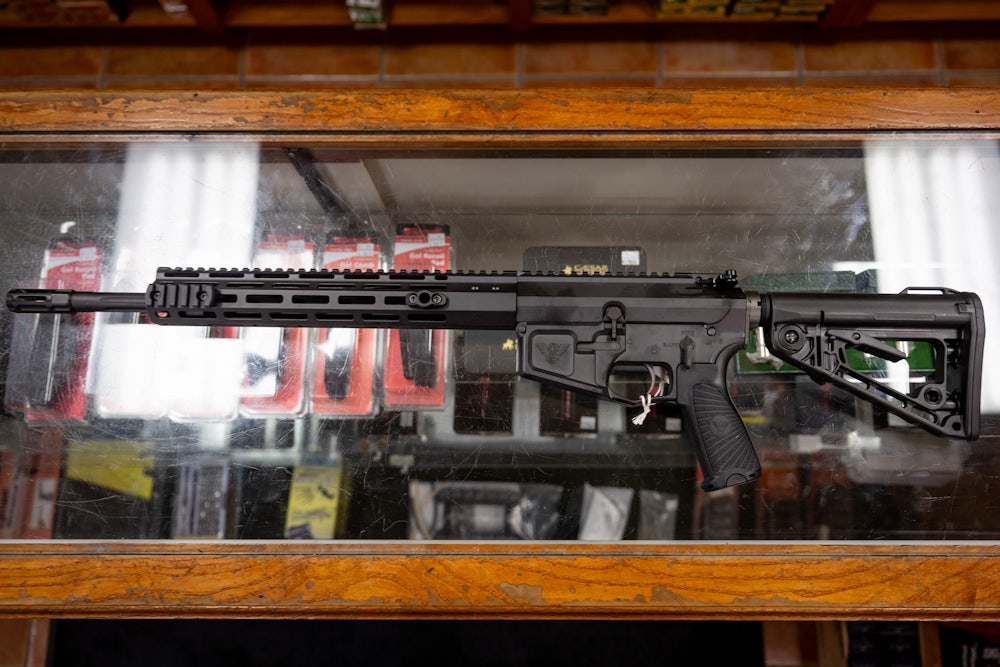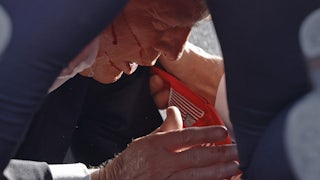“It was God alone who prevented the unthinkable from happening,” Donald Trump wrote Sunday on Truth Social, forgetting momentarily that God did not spare Corey Comperatore, the 50-year-old volunteer firefighter shot dead while throwing himself over his family to protect them, nor James Copenhaver, 74, nor David Dutch, 57, who were critically wounded in the attack. (Both were listed Sunday in stable condition.) But given what we know about the AR-15, the style of semiautomatic rifle used in the shooting, it was neither miraculous that Trump’s would-be assassin, Thomas Matthew Crooks, 20, missed Trump when firing from 164 yards away, nor surprising that Crooks killed or badly wounded three others instead.* The AR-15 is not a gun for marksmen. It’s a gun for mass shooters that the government once had the good sense to ban from civilian use. We need to ban it again.
According to Zusha Elinson and Cameron McWhirter, co-authors of the 2023 book American Gun: The True Story of the AR-15, the AR-15 is not an ideal weapon for a would-be assassin. It’s “rarely … used by snipers,” they explained Monday in The Wall Street Journal, where they’re both reporters, “because of its limited range and relatively small bullet.” Notably, the Secret Service counter-sniper who shot Crooks dead after he fired off three rounds did not use an M-4, the current military version of the AR-15, but rather an Mk13, a bolt-action rifle designed specifically for sharpshooting.
Because we live in an insane country, military sniper rifles are marketed to civilians who lack any good reason to own one. Had Crooks been a sophisticated enough killer to get such a weapon, Trump would probably be dead now. Thankfully, Crooks was not, and Trump received only a minor wound to his outer ear. Crooks was fairly clumsy with guns—so much so, two high school classmates told ABC News, that he was rejected by the school’s rifle team. “He didn’t just not make the team,” one classmate said. “He was asked not to come back because of how bad a shot he was. It was considered, like, dangerous.” The AR-15 and its ilk are frequently the gun of choice for this variety of psychopath because it makes up in destructiveness what it lacks in precision.
Mass shootings are typically committed with handguns rather than rifles, for the obvious reason that a handgun is easier to hide. But since the AR-15’s invention, in 1957, by a genius engineering autodidact named Eugene Stoner, the weapon has figured in four of the five deadliest mass shootings, including the single deadliest—the Route 91 Harvest Music Festival in Las Vegas in 2017, where Stephen Paddock killed 60 people and injured more than 850.
In 2016 Omar Mateen, wielding a variation on the AR-15, killed 49 people and injured 53 at the Pulse Nightclub in Orlando, Florida. In 2012 Adam Lanza, wielding an AR-15, killed 27 people, 20 of them children aged 6 or 7, and injured two, at Sandy Hook Elementary School in Newtown, Connecticut. In 2017 Devin Kelley, wielding an AR-15, killed 26 people and injured 20 at First Baptist Church in Sutherland Springs, Texas. AR-15s were used in the 2022 Robb Elementary School shooting in Uvalde, Texas, in which 21 people were killed, 19 of them children, and in the 2018 Marjorie Stoneman Douglas High School shooting in Parkland, Florida, in which 17 people were killed, 15 of them teenagers, and 17 injured. Taking all this into account, Stoner’s daughter Susan Kleinpell told Elinson and McWhirter that her father’s invention should not be available to civilians. “I personally don’t think there needs to be an assault rifle out on the street,” they quote her saying in American Gun.
The AR-15 came into being because military experts figured out after World War II that GI Joe wasn’t a particularly good shot. “Contrary to the public perception of soldiers as coolheaded marksmen,” Elinson and McWhirter wrote,
many fighters in battle were frightened young men pouring lead not at specific targets but in the general direction of the enemy. Combat was often at fairly close range—several hundred yards.… Whoever fired the most lead at the enemy in a battle won.
The AR-15, which Stoner developed in (of all places) Hollywood, California, solved this problem by allowing soldiers to fire many rounds at once with minimal kickback, and by rejecting the military’s bias for large-caliber bullets. True, the AR-15’s smaller-caliber bullet made a smaller hole in the human body. But on contact it “became unstable,” Elinson and McWhirter explained, and “tore through the body like a tornado, spiraling and tipping as it obliterated organs, blood vessels, and bones.” In an interactive Pulitzer Prize–winning series, The Washington Post showed, using graphic (perhaps too graphic) animation, exactly what projectiles from an AR-15 did to the young bodies of Noah Pozner, a 6-year-old killed at Sandy Hook, and Peter Wang, a 15-year-old killed at Marjorie Stoneman Douglas. “A single bullet,” the Post reported, “lands with a shock wave intense enough to blow apart a skull and demolish vital organs. The impact is even more acute on the compact body of a small child.”
As mass shootings mounted in the late 1980s, politicians started calling the AR-15, the AK-47, and similar military-style semiautomatic weapons “assault weapons.” (The term derives from a mistranslation of the name for a rifle the Nazis developed during World War II.) President George H.W. Bush considered an assault weapons ban and then, under pressure from the National Rifle Association, rejected it. But his successor, President Bill Clinton, enacted one in 1994 that specifically banned civilian sales of the AR-15, which was manufactured by Colt.
Unfortunately, the wording of the assault weapons ban was sufficiently imprecise that upstart manufacturers, and eventually Colt itself, found they could get away with creating copycat versions of the AR-15 and sneak them past regulators by tweaking this or that feature. Congress ought to have responded by toughening its assault weapons ban, but that became impossible after Republicans won the House and Senate in the 1994 midterms. Meanwhile, the outré nature of the ostensibly banned AR-15 expanded the assault rifle’s appeal to gun collectors as various knock-offs, now called “AR-15-type weapons,” proliferated. (The gun recovered at the scene on Saturday was reportedly an AR-15-style rifle.) By the time the assault weapons ban expired in 2004 the AR-15 was becoming very popular. After the ban expired, it became much more popular. Twenty years later, the AR-15 is the bestselling rifle in America.
The AR-15 isn’t much use for hunting, but that’s pretty much beside the point because as the U.S. population has shifted from rural to urban and suburban living, hunting has stopped being most people’s reason to buy a gun. What do people do with their AR-15s? Eighty-eight percent, according to a 2010 poll cited in American Gun, use them at shooting ranges; only 19 percent use them to kill animals. (For more on how urbanization pathologized American gun culture, see my 2013 New Republic piece, “How Liberals Became ‘Real Americans.’”)
Trump was president at the time of the Parkland shooting. “We have to act,” Trump said. He scolded members of Congress for being intimidated by the NRA and met with California Senator Dianne Feinstein to discuss reviving the assault weapons ban. Then the NRA arranged a private White House meeting with Trump to explain the facts of political life. After that, Trump mostly dropped talk of gun control (though he did impose a ban on bump stocks that the Supreme Court recently struck down) and said the answer to school shootings was to give schoolteachers guns. As Elinson and McWhirter pointed out in this week’s Journal piece, in 2020 Donald Trump Jr., posted a photograph of himself on Instagram hoisting an AR-15 that had a drawing on the magazine of Hillary Clinton behind bars.
Now Trump has been on the receiving end of an AR-15. He got off easy with a minor flesh wound, but others did not. Gun control tends to acquire more appeal after a person gets shot. Will Trump finally come out for an assault weapons ban? Probably not—adding one more to the long list of reasons not to reelect him president. And of course, should Trump confound expectations and come out in favor of a ban, he still shouldn’t be given a second term. But a shift by Trump on this issue might help introduce a little common sense to counter America’s fatal denialism on this topic. Whether Trump endorses an assault weapons ban or not, President Joe Biden should leverage the shooting to urge Congress to remove AR-15s from the civilian market. Where do your loyalties lie, he can ask congressional Republicans. To your standard-bearer, who almost got killed with one of these awful weapons? Or to the National Rifle Association?
* This article previously misstated the distance between the shooter and Trump.








